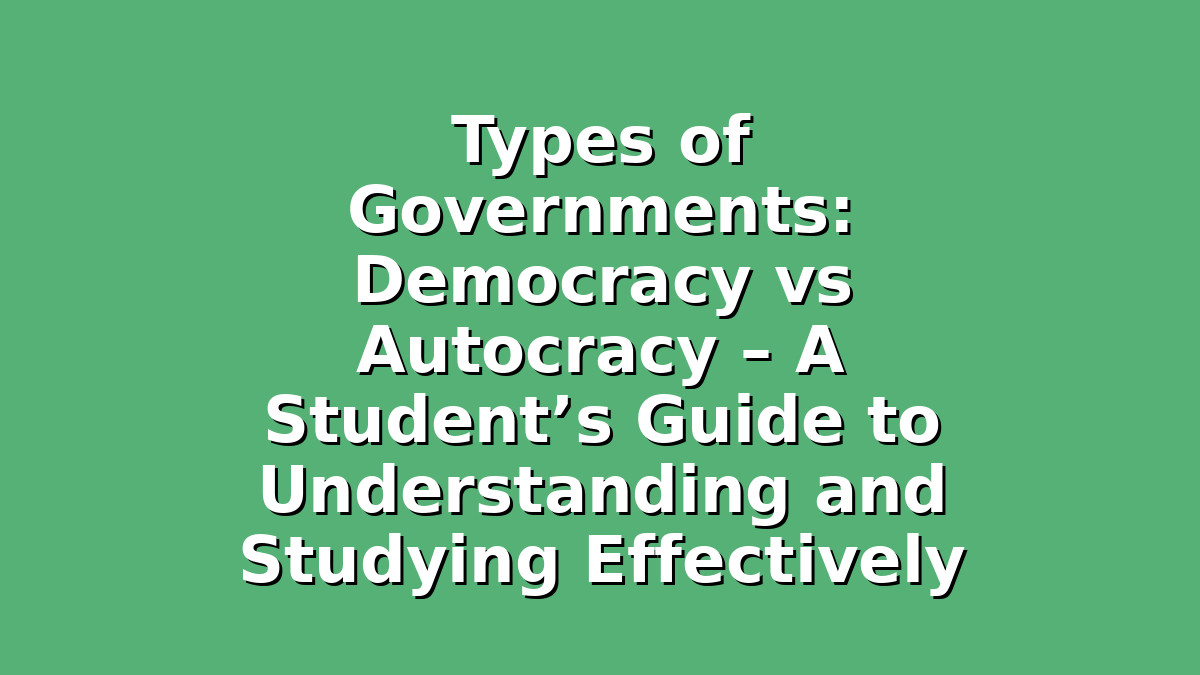When preparing for exams, especially in subjects like political science, history, or social studies, understanding different types of governments is crucial. Two of the most commonly discussed forms are democracy and autocracy. These concepts often form the backbone of many exam questions, essays, and discussions. This article will not only explain these types of governments in detail but also provide practical study tips to help you grasp the concepts quickly and retain the information effectively.
Understanding Democracy: Power to the People
At its core, democracy is a system of government where power is vested in the hands of the people. This can happen directly, where citizens participate in decision-making themselves, or indirectly, through elected representatives. Democracies emphasize freedom, equality, and participation, giving citizens a voice in how they are governed.
Key Features of Democracy:
– Free and Fair Elections: Citizens have the right to vote for their leaders.
– Rule of Law: Everyone, including leaders, must follow the law.
– Protection of Rights: Freedom of speech, religion, and press are protected.
– Separation of Powers: Government is divided into branches (executive, legislative, judiciary) to prevent abuse of power.
Study Tip #1: Create Comparison Charts
One effective study method is to create comparison charts that list the features of democracy alongside those of autocracy. This visual aid helps you quickly recall what makes democracy unique. For example:
| Democracy | Autocracy |
|—————————|—————————|
| Power rests with the people| Power rests with one ruler|
| Elections determine leaders| Leader rules without elections|
| Citizens have freedoms | Limited or no citizen freedoms|
| Multiple political parties| Often one political party or none|
Using such charts during revision sessions reinforces your understanding and makes exam recall easier.
Exploring Autocracy: Power Concentrated in One
Autocracy is a form of government where supreme power is held by a single individual, such as a monarch or dictator, or a small group. Unlike democracy, citizens typically have little or no say in governance. Autocratic rulers make decisions without requiring consent from the people or other branches of government.
Key Features of Autocracy:
– Centralized Power: One leader or group controls all decisions.
– Limited Political Freedoms: Political opposition and free speech are often suppressed.
– No Free Elections: Leaders usually come to power through inheritance, force, or manipulation.
– Rule by Decree: Laws can be made or changed at the leader’s will without public input.
Study Tip #2: Use Real-World Examples
To better understand autocracy, link theory with history or current events. Researching examples like absolute monarchies (e.g., Saudi Arabia), dictatorships (e.g., North Korea), or historical autocracies (e.g., Nazi Germany) makes the concept more concrete. Try summarizing each example in your notes with key facts:
– Who is/was the leader?
– How did they gain power?
– What freedoms were restricted?
– How did this government impact citizens’ lives?
This contextual approach not only helps you remember definitions but also prepares you for essay questions requiring critical thinking about pros and cons or outcomes of autocratic rule.
Comparing and Contrasting: Study Strategies for Success
When exams ask you to compare democracy and autocracy, it’s important to organize your thoughts clearly. Here are some strategies to deepen your understanding and improve your exam performance:
1. Mind Mapping:
Create a mind map with “Types of Governments” as the central idea. Branch out into “Democracy” and “Autocracy,” then add sub-branches for characteristics, pros and cons, and examples. This active form of note-taking strengthens memory through visual association.
2. Practice Past Exam Questions:
Look for previous exam questions on government types. Try answering them without notes first, then check your answers. This familiarizes you with the exam format and highlights areas where you need improvement.
3. Group Study and Discussion:
Sometimes discussing topics with classmates helps clarify difficult points. Organize a study group to debate which system might be better in different scenarios. Teaching others is also a proven way to reinforce your own knowledge.
Study Tip #3: Use Mnemonics
To remember the characteristics of democracy and autocracy, use mnemonics – a memory technique that turns information into catchy phrases or acronyms. For example, to recall democracy’s features, you might use:
FREP – Free elections, Rights protected, Equal participation, Powers separated.
For autocracy, try:
CAP – Centralized power, Authority unchecked, People’s rights limited.
These quick cues can be lifesavers during last-minute revisions or exams.
Conclusion: Mastering Government Types with Confidence
Understanding types of governments like democracy and autocracy is essential for many exams. By breaking down their characteristics, using real-world examples, and employing effective study techniques like charts, mind maps, and mnemonics, you can boost your confidence and improve retention. Remember, consistent revision and active learning are your best friends when preparing for any exam. Stay curious, keep practicing, and trust that your hard work will pay off. You’ve got this!

Responses